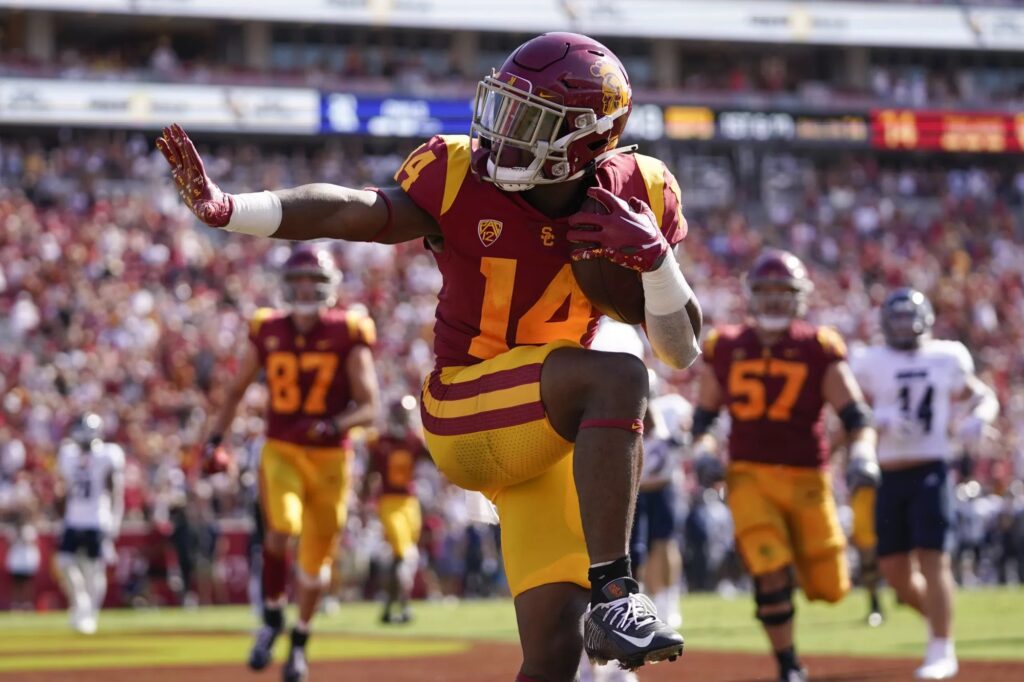Meet Raleek Brown, a Stockton youth football legend churning toward USC fame
Ryan Kartje (LA Times) — Sometimes, you just know. You feel it deep in your gut. Not so much an instinct as an instant, unimpeachable sense of certainty so clear nothing could convince you otherwise.
That’s how Mori Sue’sue felt seeing Raleek Brown on a football field. He just knew. He knew before warmups of that first Little League All-Star tryout were finished. He knew by the way Brown moved at just 12 years old, so sudden and yet so smooth, deftly cutting on one dime after another, speeding past one … two … three … four unsuspecting defenders with ease. He knew the way those in Brown’s hometown of Stockton will tell you they’ve always known — at least since crowds started forming to see the young football phenom they once called “Mighty Mouse.”
Others who ushered Brown along the way, from the Southside Vikings all the way to USC, offer a similar explanation for how they came to believe Brown was bound for stardom. They just knew, they say — always with the same emphasis on the word.
At USC, teammates took all of a few days during preseason camp before treating the freshman’s bright future as a foregone conclusion. Eyes light up whenever they’re asked about Brown.
“It’s something I [saw] Day 1,” says USC receiver Tahj Washington.
“It amazes me,” adds Austin Jones, a fellow USC running back. “[I was] just sitting back in fall camp, like, ‘This dude is real.’”
Until that tryout, Sue’sue had yet to hear much about him. But Brown’s father, Roscoe, was familiar with Sue’sue. His reputation in Northern California as a respected local seven-on-seven coach and talent evaluator preceded itself. So Roscoe approached him hoping he’d take a look at his son. He knew Sue’sue was working with Najee Harris. Before that, he trained Joe Mixon. Both would wind up as the No. 1 backs in their recruiting class, before becoming two of the best in the NFL.
Which is to say, Sue’sue knew a good running back when he saw one. “I haven’t missed on a kid yet,” he says.
And in the case of this particular kid, he was convinced. So much so that later that summer, he and his friend and fellow coach, Stuart Tua, sought to test the boundaries of Brown’s extraordinary talent.
Six years before he struck the Heisman pose in the Coliseum end zone, boldly announcing his arrival during USC‘s 2022 season opener, the two coaches brought Brown to campus for one of the Trojans’ elite football camps. He was still just 12 years old. But the coaches say they were able to sneak him in, with the intent of testing him against several top high school prospects.
It was a bold plan, but the two coaches say they were sure of the kid’s ability. They didn’t disclose to anyone he was still in grade school. Not until near the end of the camp, when Keary Colbert, a friend of theirs who was a USC assistant at the time, approached with news.
“KC comes over and tells us, ‘Hey, just to let you know, your kid is going to win the MVP for running backs at the camp,’ ” Sue’sue said. He chuckles thinking back. “Mind you, these are the best of the 10th-and 11th-graders.”
“I laughed out loud,” Tua added. “There were some four- and five-star linebackers that he’d made look pretty silly. No one had any idea he was 12 years old.”
They fessed up to Colbert, who couldn’t believe it.
Brown didn’t officially win MVP that day … for obvious reasons. But his performance made believers of USC’s staff, which waited until the summer before he started high school to officially offer him a scholarship.
Talk to those around Brown, and they say they’ve always known he’s on the path to something extraordinary. And soon, they insist, everyone else will know too.
Roscoe Brown was sure his son would be special just watching Brown run around the yard as a toddler. He knew because, years ago, he’d been a sprinter at Edison High in Stockton, specializing in 100- and 200-meters. He understood speed. And his son, he soon learned, was a special kind of fast.
Those early assumptions were confirmed soon after Brown’s fourth birthday, when Roscoe first signed him up for flag football. In his competitive football debut, Roscoe recalls, Brown scored at least five touchdowns. He lasted just a single season in that league, before Roscoe moved him up to contact.
From then on, his father says, “we always had to move him a couple years ahead of his age group. He was just always ahead of his time.”
However far ahead he moved, Brown still seemed to sprint past expectations. Soon enough, they lost track of his touchdowns. In his second season of contact football, Roscoe estimates his 6-year-old son scored something like 72 times, but he can’t say for sure. The crowds started forming after that.
His pure speed seemed to translate at every level, so Roscoe trained him to harness it. He entered him into FBU football camps, starting in the fourth grade, just to challenge him. But eventually, it became clear his son needed additional guidance. So Roscoe sought out Sue’sue’s help.
“As soon as he saw Raleek touch the ball, it was a no-brainer,” Roscoe said. “He hasn’t left his side since.”
That summer, Sue’sue brought the young back to tryouts for his seven-on-seven team so Tua, his trusted fellow coach, could see Brown for himself.
“It took basically two or three plays for me to realize, oh, this is the best back we’ve got,” Tua said. He surprised even Sue’sue by immediately elevating Brown to starting running back.
The decision upset some parents whose sons were starting running backs on their respective high school teams.
“So,” Tua explains, “I told them, ‘Let’s settle this right here.’ I brought Raleek out, and I had these two kids guard Raleek, then I had Raleek in turn guard them. Let’s just say the outcome was not good for them.”
They took him to USC’s campus a couple months later. Brown got his first Power Five offer, from Brigham Young, that summer, essentially on Sue’sue’s word alone.
Word soon started to trickle out about Brown. In the meantime, he had no choice but to return to Stockton Little League football.
“He’d just gotten done dominating high school kids,” Sue’sue said, with a laugh. “It was honestly dumb.”
Booker Guyton knew well before Brown’s arrival at Edison High he was a different type of talent than Stockton had seen in some time. Maybe ever. There were already YouTube highlight reels. “He was a folk hero by the time he was 8 years old,” Guyton says.
Curious, the Edison coach once invited the Pop Warner phenom and his father to a varsity practice. When he saw Brown on the sideline, he told him to throw on some cleats.
“The route he ran was so explosive and so abusive to the DB that I looked at his dad and told him, ‘Man, he could play varsity right now,’” Guyton says.
No one was surprised when Brown took over immediately as a freshman at Edison and never looked back, racking up 2,429 total yards and 28 touchdowns. He was named MVP of the conference as a first-year running back. Brown made his presence felt in other ways, too, as Edison won its first league title in more than 40 years.
During his first high school game, Guyton recalls one play in which Brown caused a fumble on defense, only to turn around and lead the way as a blocker for a teammate, who returned the fumble for a score.
“Who does that as a ninth grader?” Guyton says. “You can’t coach that.”
Guyton told Roscoe he believed his son would put Edison “on the map.” But Brown was dominating with such ease that those closest to him wondered if he’d ever be challenged enough at Edison. He ultimately stayed as a sophomore and repeated as MVP, racking up 26 more touchdowns, which only deepened that sentiment.
His decision to transfer wasn’t about football alone. Roscoe also worried about the violence and high crime rate in their hometown. “I didn’t want him around it no more,” he said.
Some in Stockton understood. Guyton admits he wasn’t one of them initially.
“He captured the community,” Guyton said. “People who didn’t even root for Edison were coming to watch football, you know, to watch this kid play. So when he left, it shook up our city. … But he wanted a bigger challenge, and he went and got that at Mater Dei.”
Bruce Rollinson had his own questions about how much competition Brown faced in his first two years. On tape, he was “dazzling,” the Santa Ana Mater Dei coach recalled. But would he really be that electrifying in the Trinity League?
He got his answer as soon as Mater Dei started seven-on-seven work.
“I gotta admit, I just went, ‘Whoa,’” Rollinson said. “I knew then this was a generational kid.”
Still, not everything came as easily for Brown at Mater Dei. Academically, the transition was a tough one. But he had a way of endearing himself to teachers, who often raved to Rollinson about Brown. There was energy about him that people gravitated toward.
For the first time, Brown also had to earn his place on a football field. Rollinson ran a far more rigorous, structured program than he’d ever experienced in Stockton. It took some adjusting.
“He was used to you know, drink a half-bottle of water, touch the toes a couple times and off I go,” Rollinson said.
Brown still had to learn some of the finer points of the position too.
“He’d never probably had to pass pro in his life,” Rollinson said, “and that was a project.”
The pandemic delayed his debut at Mater Dei to spring and nagging, soft-tissue injuries would follow him into summer. But the following fall, Brown wasted no time in making a statement. In his season debut as a senior, Brown ripped off a 78-yard touchdown run against Duncanville, a Texas prep powerhouse, on his first carry.
Raleek Brown celebrates against San Mateo Serra in the CIF State Open Div tournament on Dec. 11. (Allen J. Schaben / LAT)

